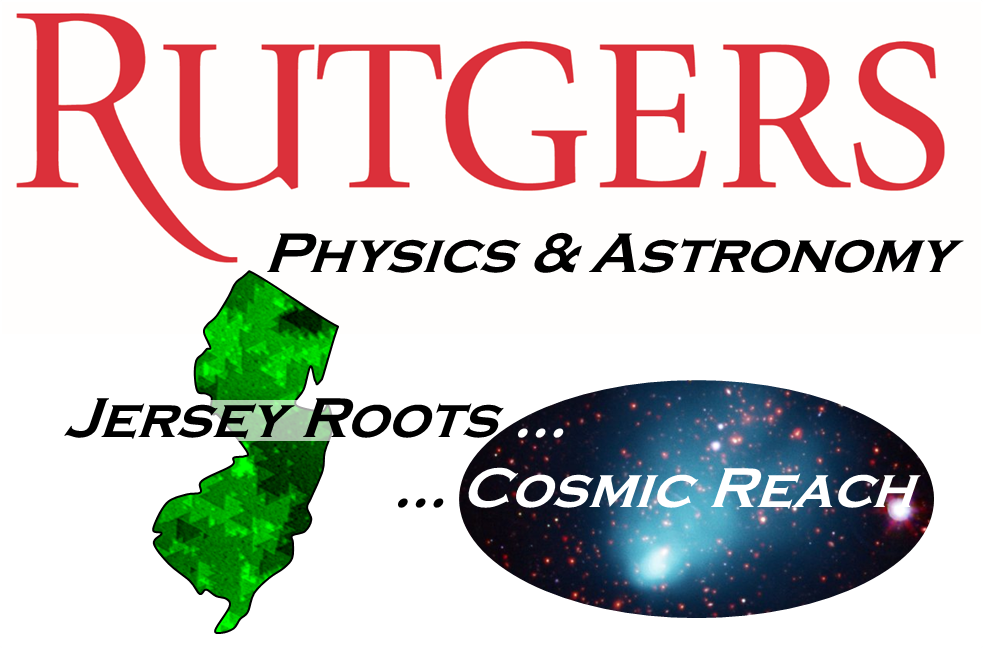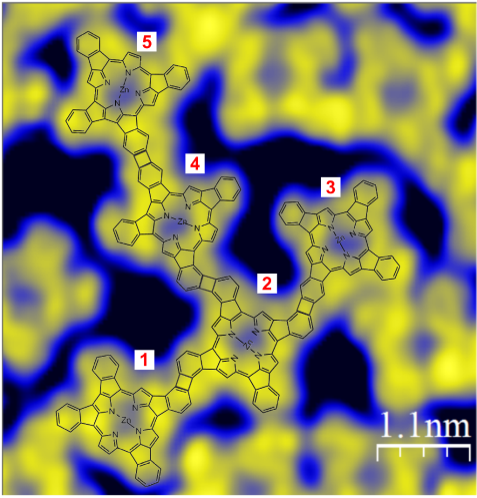

LINKS
|

Research Overview
Our research focuses on determining the electronic properties of
surfaces, interfaces, ultrathin films and nanoscale structures using a number of
experimental approaches. Our work spans a wide range of materials systems
from simple metals to complex oxides. Current projects include
studying fundamental aspects of organic molecule adsorption on crystalline oxide
and metal surfaces for photovoltaics and organic electronics;
probing the electronic structure and morphology of transition metal
oxyfluorides for energy storage applications;
investigating structure-reactivity relationships of gas-phase reactions
catalized at nanofaceted surfaces; exploring the role of radiation-induced
reactions in materials that are candidates for resists
in extreme ultraviolet lithography; and exploring energy and momentum
correlations between coincident pairs of photoemitted electrons.
We use a variety of techniques to perform these studies including
high-resolution and angle resolved photoemission spectroscopy, inverse photoemission spectroscopy using a newly
developed grating spectrograph, the novel technique of
Auger-photoelectron coincidence spectroscopy (APECS) with
synchrotron radiation (which was developed in our labs), and a
variety of scanning probe techniques including variable temperature
STM and AFM.
Please click on the links at the left for more
information. |
Recent Highlight
Surface-mediated growth of covalently bonded 2D networks
When raised to elevated temperatures, Zinc tetraphenyl porphyrin molecules on the Ag(100) surface
 dehydrogenate, transform conformationally, and form new intramolecular covalent bonds.
Importantly, further annealing results in INTERmolecular covalent bonding and the formation of covalently
bonded networks as shown in figure at the left. These networks provide direct evidence that surface-mediated
dehydrogenation can be used to form novel 2D materials, with unit cells based on organic or organometallic
molecules. We are now working to control these surface-mediated mechanisms and trans-form the highly ordered
arrays of self-assembled organic molecules into covalently bonded 2D materials. We are working to
create self-assembled monolayers of organic molecules and convert them directly into a covalently bonded system.
New 2D materials fabricated with this approach may exhibit exotic properties such as Dirac cones, topologically
protected edge states, the quantum anomalous Hall effect, or high temperature ferromagnetism.
(Learn more)
dehydrogenate, transform conformationally, and form new intramolecular covalent bonds.
Importantly, further annealing results in INTERmolecular covalent bonding and the formation of covalently
bonded networks as shown in figure at the left. These networks provide direct evidence that surface-mediated
dehydrogenation can be used to form novel 2D materials, with unit cells based on organic or organometallic
molecules. We are now working to control these surface-mediated mechanisms and trans-form the highly ordered
arrays of self-assembled organic molecules into covalently bonded 2D materials. We are working to
create self-assembled monolayers of organic molecules and convert them directly into a covalently bonded system.
New 2D materials fabricated with this approach may exhibit exotic properties such as Dirac cones, topologically
protected edge states, the quantum anomalous Hall effect, or high temperature ferromagnetism.
(Learn more)
|
Recent
Publications
2018
-
Self-assembled monolayers on single crystal rubrene surfaces: Competition between anchor groups and alkane tails
Sylvie Rangan, Aleksandra B. Biedron, Elena Galoppini,
Vitaly Podzorov, Edward W. Castner, Jr., and Robert A. Bartynski to be submitted (2018)
-
Growth of a highly ordered, kinetically trapped molecular monolayer on a metal surface
Sylvie Rangan, Peter Kim, Charles Ruggieri,
Robert A. Bartynski and Steven Whitelam,to be submitted (2018)
-
Rubrene vs. fluorinated-functionalized rubrene molecules: self-assembly, electronic
structure and energy alignment
Jonathan Viereck, Sylvie Rangan, Peter Kim, and Robert A. Bartynski,
J. Phys. Chem C submitted (2018)
-
Full energy spectrum of electrons emitted from Ag(100) as a result of N2,3VV
Auger transitions: Experiment and theory
P.V. Joglekar, R. W. Gladen, K. Shastry, V. A. Chirayath,
Q. Dong, S. L. Hulbert, R. A. Bartynski, Wolfgang S. M. Werner and A. H. Weiss, Phys. Rev. B submitted (2018)
-
Electric-field effect on photoluminescence of lead-halide perovskites
Hee Taek Yi , Sylvie Rangan, Prakriti P. Joshi, Boxin Tang,
C. Daniel Frisbie, Robert A. Bartynski, Xiaoyang Zhu and Vitaly Podzorov, Nature Materials submitted (2018)
-
The Vacuum-Liquid Interface of Silicon Functionalized Ionic Liquids
Aleksandra B. Biedron, Boning Wu, Takatsugu Endo, Kenji Takahashi, Robert A. Bartynski,
Eric L. Garfunkel, Edward W. Castner, Jr., and Sylvie Rangan, to be submitted (2018)
-
Excitation and decay of aluminum bulk plasmon at aluminum/copper phthalocianyne interface
Gianluca Di Filippo, Marco Sbroscia, Giovanni Stefani,
Robert A. Bartynski, and Alessandro Ruocco, Phys. Rev. B 97, 235420 (2018)
2017
-
Electronic structure, excitation properties, and chemical transformations
of extreme ultra-violet resist materials
Sylvie Rangan, Robert Bartynski,
A. Narasimhan, and R.L. Brainard, J. Appl. Phys. 122, 025305 (2017)
-
Adsorption Geometry and Energy Level Alignment at the PTCDA/TiO2(110) Interface
Sylvie Rangan, Charles Ruggieri, Robert Bartynski,
Jose Ignacio Martínez, Fernando Flores, and Jose Ortega, J. Phys. Chem. B 122, 534 (2017)
-
Unveiling universal trends for the energy level alignment in organic/oxide interfaces
Jose Ignacio Martínez, Fernando Flores, Jose Ortega,
Sylvie Rangan, Charles Ruggieri, and Robert Bartynski, Physical Chemistry Chemical Physics 19, 24412 (2017)
2016
-
Nanoscale Internal Fields in a Biased Graphene-Insulator-Semiconductor Structure
Sylvie Rangan. Malathi Kalyanikar, Junxi Duan, Gang Liu,
Robert Allen Bartynski, Eva Y. Andrei, Leonard Feldman, and Eric Garfunkel, J. Phys. Chem. Lett. 7, 3434 (2016)
-
Densely Packed ZnTPPs Monolayer on the Rutile TiO2(110)-(1×1)
Surface: Adsorption Behavior and Energy Level Alignment
Sylvie Rangan, Charles Ruggieri, Robert Bartynski,
Jose Ignacio Martínez, Fernando Flores, and Jose Ortega, J. Phys. Chem. C 120, 4430 (2016)
-
Zinc(II) Tetraphenylporphyrin on Ag(100) and Ag(111):
Multilayer Desorption and Dehydrogenation
Charles Ruggieri, Sylvie Rangan,
Robert Bartynski, and Elena Galoppini, J. Phys. Chem. C 120, 7575 (2016)
-
Heterogeneous Electron-Transfer Dynamics through Dipole-Bridge Groups
J. Nieto-Pescador, B. Abraham, J.J. Li,
A. Batarseh, R.A. Bartynski, E. Galoppini, and L. Gundlach, J. Phys. Chem. C 120, 48 (2016)
2015
-
Chemical Interaction, Space-Charge Layer, and Molecule Charging Energy
for a TiO2/TCNQ Interface
J. I. Martínez, F. Flores, J. Ortega, S. Rangan,
C. Ruggieri, and R.A. Bartynski, J. Phys Chem. C 119, 22086 (2015)
-
Investigation of SEI Layer Formation in Conversion Iron Fluoride Cathodes by
Combined STEM/EELS and XPS
M. Sina, R. Thorpe, S. Rangan, N. Pereira,
R. A. Bartynski, G. G. Amatucci, and F. Cosandey, J. Phys. Chem C 119, 9762 (2015)
-
The Solid State Conversion Reaction of Epitaxial FeF2(110) Thin Films with Lithium Studied by
Angle-Resolved X-Ray Photoelectron Spectroscopy
Ryan Thorpe, Sylvie Rangan, and Robert A. Bartynski,
Ryan Whitcomb, Ali C. Basaran, Thomas Saerbeck, and Ivan K. Schuller, Phys. Chem. Chem. Phys. 17 15218 (2015)
-
Symmetry Breaking Charge Transfer in a Zinc Chlorodipyrrin Acceptor for High Open Circuit Voltage
Organic Photovoltaics
Andrew N. Bartynski, Mark Gruber, Sylvie Rangan, Sonya Mollinger,
Cong Trinh, Saptaparna Das, Stephen E. Bradforth, Koen Vandewal, Alberto Salleo, Robert A. Bartynski,
Wolfgang Brutting, and Mark E. Thompson, JACS 137, 5397 (2015)
-
Zinc(II) tetraphenylporphyrin adsorption Au(111): an interplay between molecular
self-assembly and surface stress
Charles Ruggieri, Sylvie Rangan, and Robert Allen Bartynski
and Elena Galoppini, J. Phys. Chem. C 119, 6101 (2015)
-
Synthesis of Zinc Tetraphenylporphyrin Rigid Rods with a Built-in Dipole
Keyur Chitre, Alberto Batarseh,
Andrew Kopecky, Hao Tang, Roger Lalancette, Robert A. Bartynski and
Elena Galoppini, J. Phys. Chem. B 119, 7522 (2015)
-
Selective Oxidation of Ammonia by Co-adsorbed oxygen on iridium surfaces:
Formation of N2O
W. Chen, Q.T. Shen, R.A. Bartynski,
ACS Catalysis Letters, DOI 10.1007/s10562-014-1468-1 (2015)
-
Photoelectrochemical properties of porphyrin dyes
with a molecular dipole in the linker
K.T. Ngo, J. Rochford, H. Fan, A. Batarseh,
K. Chitre, S. Rangan, R.A. Bartynski, and E. Galoppini,
Faraday Discussions 185, 497 (2015)
-
Oxygen-induced nano-faceting of Re(1121)
Hao Wang, Wenhua Chen, and R.A.
Bartynski, Surface Science, 635, 85 (2015)
2014
-
Theoretical study of carbon on Re surfaces: Morphology Instability
Agham Posadas, Andrew O'Hara,
Sylvie Rangan, R.A. Bartynski, and Alex Demkov, Applied Phys. Lett. 104, 092901 (2014)
-
Measurement of the background in Auger-photoelectron coincidence spectra (APECS)
associated with inelastic or multi-electron valence band photoemission processes
S. Satyal, P.V. Joglekar, K. Shastry,
S. Kalaskar, Q. Dong, S.L. Hulbert, R.A. Bartynski, and A.H. Weiss,
J. Elect. Spect. Rel. Phenom. 195, 66 (2014)
-
Tuning Energy Level Alignment at Organic/Semiconductor Interfaces
using a built-in dipole in chromophore-bridge-anchor compounds
S. Rangan, A. Batarseh, K. Chitre,
A. Kopecky, E. Galoppini, and R.A. Bartynski, J. Phys. Chem. C 118, 12923 (2014)
-
Energy Level Alignment of Polythiophene/ZnO Hybrid Solar Cells
W. Feng, S. Rangan, Y. Cao, E. Galoppini, R. A. Bartynski,
E. Garfunkel, J. Mat. Chem. A 2, 7034 (2014)
-
Nano-Faceted Metal Surfaces: Structure, Reactivity and Applications,
Wenhua Chen, Hao Wang, and R.A. Bartynski,
invited book chapter in Catalysis by Materials with Well-Defined Structures, Elsevier (2014)
-
Band gap of epitaxial in-plane-dimerized single-phase NbO2 films,
Agham Posadas, Andrew O'Hara, Sylvie Rangan,
R.A. Bartynski, and Alex Demkov, Applied Phys. Lett. 104, 092901 (2014)
-
Nitrogen-induced reconstruction and faceting of Re(1121)
Hao Wang, Wenhua. Chen, R.A. Bartynski, P. Kaghazchi,
and T. Jacob, Journal of Chemical Physics 140, 024707 (2014)
| |

